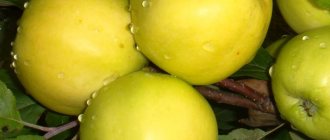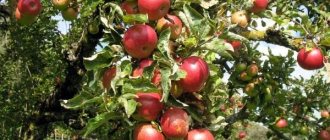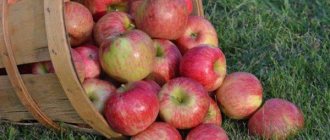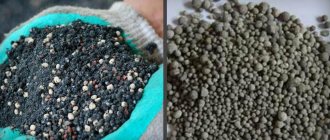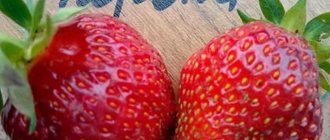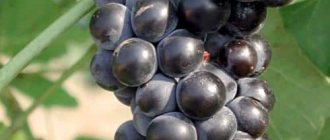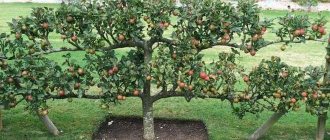Growing apple trees in the Urals is not easy due to difficult climatic conditions and frequent outbreaks of diseases. Relatively short and cool summers, long and cold winters - all this plays against heat-loving crops. But, in general, the apple tree is a fairly resilient tree, and thanks to the efforts of breeders, qualities are instilled into it that increase its value - winter hardiness and high immunity. In 2004, the Ural Federal Agrarian Research Center of the Ural Branch of the Russian Academy of Sciences submitted an application for registration of a new variety with the optimistic name Good News. In the same year, the new product was included in the State Register of Breeding Achievements of Russia for the Volga-Vyatka region, which includes the Kirov, Nizhny Novgorod, Sverdlovsk regions, Perm Territory, the Mari El Republic, the Udmurt and Chuvash Republics. As the parent form, the author of the new variety L.A. Kotov used the Krasa Sverdlovsk apple tree, which is quite common in the Urals, crossing it with the immune form X-2034. From her parent, Good News inherited not only her bright appearance, but also excellent characteristics.
Our heroine should not be confused with another variety - Blagovest. Despite the consonant name, this is an independent species, zoned in the Central Black Earth region.
Description and photo of the variety Good News
- Late winter variety . We got it by crossing Krasa Sverdlovsk and the immune form X-2034;
- Medium sized tree. And the crown is not that thick. Quickly gains its shape;
- Brown-colored and medium-sized pubescent shoots have characteristic knees. Not straight;
- The dark green and smooth small leaves are oval in shape;
- The fruits are round. Some people also see a barrel in them. So they call them barrel-shaped. Their sizes are approximately the same. From 85 to 120 grams.
Apple tree fruits Good news.
Interesting digression:
- I always smile when they indicate the weight of apples with an accuracy of 5 grams. And definitely 85 grams. I would like to ask those who carried out the weighing. Where did you get the apple?
- Every gardener knows that the weight and size of apples, even on the same tree, are not the same. There are big ones. There are small ones. And there are averages between them. And when purchasing them on the market, you try to take larger and more beautiful ones;
- That’s why you and I will smile at the phrase from one article: “The fruits are round. Correct shape. Weight 85 grams."
Very attractive in appearance - yellow with a pink blush. There are few subcutaneous points on the apple. But there are them too. Although not that noticeable. With creamy, dense, fine-grained and juicy pulp. Great taste. Sweet and sour. With high ratings from tasters . They also note a weak aroma.
Apples Good news.
Varieties
The main variety Good News has varieties: standard variety and Blagovest. They have similar descriptions to the main variety.
Apple tree standard Good news
Practically no different from the main type. It is classified as a creeping variety in the form of a shrub. The tree is compact, reaches 2 m in height. The apples are medium in size and taste sweet and sour. The color is yellow with a pink blush.
Blagovest
This variety is more suitable for cultivation in the Central region and the Black Earth region. The tree is compact, the crown is round. The apples are medium in size and taste sweet. There is no resistance to scab, winter hardiness is preserved. Moisture-loving culture.
additional characteristics
Advantages and disadvantages
- Scab-immune variety;
- High winter hardiness;
- Long shelf life;
- Very tasty.
Dimensions of an adult tree
- On a seedling rootstock. Quite large trees. When they grow up. Beautiful round shape. Like a ball;
- On semi-dwarf rootstocks. Medium sizes. And the form is the same.
Good news on seedling rootstock.
Annual growth
- The shoots are evenly distributed throughout the crown;
- Medium vigor.
Frequency of fruiting
- The variety does not force you to do calculations: is this the right year for it to bear fruit?
- It bears fruit regularly;
- And your concern will be in preserving these delicious apples.
The good news bears fruit regularly.
Productivity
- Many gardeners who grow apple trees of this variety and eat such apples do not particularly focus on their yield;
- Although it is not as high as many well-known industrial varieties. Apparently, for them, productivity does not come first;
- But farmers share little information. They have no time!
Tasting assessment
- its tasting score is 4.8 points
- And these are not only tasters from the Urals, Siberia and Altai.
The fruits of the Good News have a high tasting rating.
Winter hardiness
- The winter hardiness of this variety may be the envy of other varieties;
- And gardeners in the Urals, Siberia and Altai successfully grow this variety on their plots;
- They also advise growing it in milder areas.
Resistance to scab and other diseases
Scab is really ahead of all apple tree diseases:
- It may leave you without a harvest of your favorite apples. Who will like it;
- The winter hardiness of the tree also decreases;
- So scientists are working to create scab-resistant varieties. Including immune ones.
Apple tree varieties are divided into:
- Immune to five races (there are only five of these races);
- Immune to four races;
- Varieties with so-called field resistance. Its degrees: low;
- average;
- high.
Advice! Plant a Good News apple tree that is immune to all five races. And you won't even think about this problem. This allows you to successfully resist other diseases.
Reviews
Leonid. “For our places (and this is Bashkiria), among winter varieties, I would give preference to the Good News variety. This is truly a wonderful result of the Ural gardeners. And Kotov’s varieties deserve attention and respect. Reliable. They have just started to bear fruit for me. I will check their stated characteristics. But the taste and appearance completely satisfy me. I won’t say anything about keeping quality yet. But in March we still ate apples. I advise others to purchase this variety. I don't write about illnesses. There were no problems."
Stanislav. “I specifically purchased a Kotova Blagovaya Vesti apple tree for my garden because I liked the photo and description of the variety. Through reliable channels. So that there are no mistakes with the variety. And she didn't disappoint me. After all, there is a lot of talk about how local varieties are not very tasty. And it's not just delicious. It is very tasty. And fragrant. And it is stored until April. No special conditions. Add to everything that I said that this is an immune variety to scab. About low yields. Everyone has their own criteria. Our family has enough apples. But they advise you to think about good pollinators nearby.”
Michael. “An excellent winter apple variety for the Urals and surrounding areas. Please note that not so long ago there were no such gardens in our area. The gardeners had something. I have several Ural varieties - Silver Hoof, Krasa Sverdlovsk, Issetskoe later, Good News. I'm happy with everyone. Of the later ones, of course, is Good News. This is our family's favorite. Juicy, Fragrant. And this is in March. True, their productivity is not so high. But that’s what other apples are for. And to compare with each other.”
Productivity
Up to 40 kilograms of apples are harvested from one tree of this variety, and with good care, even more. You can save Good News apples all winter, until spring.
Apple picking
To avoid damaging the fruit branches, remove the apples carefully. Holding the fruit with one hand, turn it around the stalk. The other hand holds a twig.
How to store
The apples are sorted, each one is wrapped in paper and placed in wooden boxes. The volume in one container should not exceed 15-30 kilograms. Fruits are best preserved in a cool, dark room with good ventilation. The temperature in the basement should be from 0 to +1 degrees.
Features of planting and caring for an apple tree
Planting dates and scheme
There are no recommendations for the exact planting date of this variety. As for all apple trees. And various circumstances may make adjustments to these dates. Planting can be done both in spring and autumn. Focus on specific weather conditions:
- Spring: suitable period - April;
- the buds have not yet bloomed;
- but the soil has already warmed up.
- the leaves have fallen;
Watch a video about planting an apple tree in the spring: And a video about the features of autumn planting: Tips:
- Do not plant in wet soil in rainy weather;
- If it’s autumn like this, bury the seedling. Cover well for the winter.
You will select the distances between trees taking into account the rootstock of the seedlings. In rows it will be 3-4 meters apart on seedlings. And on dwarfs up to 3 meters.
Attention! Keep an eye on the root collar. It should not be buried. 4-6 cm above ground level. After the soil has settled.
Agricultural technology and cultivation
- Choose a suitable location and soil: Well-lit and exposed to sunlight;
- Light (loamy and sandy loam) soil.
- Biennial and with a good root system.
- Keep the soil in good condition: Systematically loosen and mulch.
- Two or three waterings may be sufficient. And then the weather will tell you;
- From the second year. Fertilize together with root watering. Foliar ones are also quite effective.
- The creators took care of counteracting diseases;
Treatment of the garden in the fall from pests and diseases.
Important! Pay serious attention to preparing the apple tree for winter and protecting it from rodents.
Rootstock for variety
You can purchase and grow this variety as a seedling. But they are often offered on semi-dwarf rootstock 54-118. Who needs what!
Pruning and crown formation
Prune in the spring before the buds open. But adjustments to green shoots can be made during the summer. These could be cuttings:
- Formative;
- Sanitary;
- Rejuvenating.
And the shape of the crown will be determined by your ideas and fantasies. Traditional and natural:
- Sparsely tiered;
- Cupped.
are very popular these days :
- Fusiform;
- Palmettes;
- Cordons;
- Creeping.
Palmetta.
And in the next video you will see how to form a creeping crown:
Pollinator varieties
- Varieties with the same flowering period planted nearby will only contribute to good pollination of the variety;
- Including Ural varieties;
- Apiaries near the garden are just a dream for a gardener.
How to plant a tree on a plot
The landing procedure has its own characteristics and nuances. You need to study the algorithm, soil composition, recommended location.
Selecting and preparing a landing site
The place should be well lit, protected from strong gusts of wind, and not shaded. Groundwater should be at a depth of no higher than 1.5 m.
They begin to prepare the planting hole in advance. Dig it out, then mix the soil from the hole with:
- 10 kg of humus;
- 300 g superphosphate;
- 200 g of potassium salt.
Half of the mixture is poured back and left for 14 days.
Dimensions and depth of the landing pit
The Good News apple tree is medium sized. A hole is prepared for it with a depth of 70-80 cm and a diameter of 70 cm. It is made in the shape of a circle or square.
Timing and step-by-step algorithm for planting an apple tree
Planting is carried out in the spring, when the soil warms up to 10 °C. The procedure is carried out following a certain algorithm:
- The roots of the seedling are immersed in water with a weak solution of manganese for 24 hours.
- Then the plant is lowered to the bottom of the hole.
- Straighten the roots with your hands.
- Gradually cover the plant.
- Compact the soil with your hands after each layer.
- Form a trunk circle 10 cm deep.
- Water with 4-6 buckets of water.
To protect the apple tree from strong winds or rain, before planting, drive a wooden stake and tie the plant to it.
Features of ripening and fruiting
Fruiting
Start
- When you plant a seedling, make a mark on your calendar. To make sure in five years that there are already apples;
- And appreciate their taste. If you looked after her correctly.
The good news begins to bear fruit in the fifth year.
Peculiarities
- The size of the fruits and their harvest maturity depend on agrotechnical practices and quality care of the apple tree ;
- Fruits every year.
Deadlines
Blooms
- And apple trees bloom in May;
- Beautiful. And they delight those who care.
Fruit ripening
This is the Yaroslavl region. Ripen at the end of September. Sometimes in early October.
The fruits of the Good News ripen at the end of September.
Harvest storage
- You can store amazing and delicious apples until the end of March;
- One gardener kept it in a plastic bag until May;
- I couldn't stand it. I would eat it.
Agricultural technology
At first, the apple tree is watered regularly, 3-4 times a month, and if the weather is dry - twice a week.
In mid-April, root fertilizing is carried out with nitrogen fertilizers, and during flowering - with potassium and phosphorus fertilizers. In summer, potassium and phosphorus mixtures alternate with nitrogen ones. In the fall, it is good to add compost and rotted manure.
Annual sanitary pruning of the tree is necessary, in which case damaged shoots and dried branches are removed.
A prerequisite for good care is cleanliness of the tree trunk circle.
It is regularly weeded and mulched. At the beginning of spring, the tree trunk circle and bark are sprayed against pests that have overwintered there. Also, control measures are carried out before and after flowering, and spraying against codling moths is carried out 20 days before fruit ripening.
Ripening and harvesting
Fruits can be stored fresh for five months
In the 4th year of the tree’s life, you can try a few apples, but real fruiting begins in the 5th year.
The fruits ripen from mid-September to early October (with warm, sunny summers, ripeness occurs earlier). Ripe ones hold well on the branches, so there are no problems with harvesting.
The shelf life of fruits at a temperature of 0-1°C is 5 months.
Growing in regions
In the Urals and similar climatic regions, the variety grows well and bears fruit.
Thanks to its frost resistance, it can be grown in the Siberian region, but at the same time it can be insulated before the onset of winter.
Apple trees can be grown without problems in temperate and warm zones, often producing sweeter and larger fruits.
Apple Tree Good News
Stambovaya
What apple tree does not have a trunk? Right:
- Creeping;
- Formed by a bush.
And on clonal rootstock 54-118 you can grow a semi-dwarf apple tree of medium height. But half the size of an apple tree on a seedling. For 370 rubles.
The apple tree rootstock is semi-dwarf 54 - 118.
Growing in regions
In the Urals
- In Bashkiria it is called the best winter variety . True, they add the word “apparently”;
- Mordovian gardeners are not overjoyed . After all, it is included in the state register in the Volga-Vyatka region. They offer it in their nurseries.
In the Altai region and Siberia
Due to its novelty, not everyone has yet been able to appreciate its benefits. And dignity. Or maybe we don’t see publications by Altai gardeners so often. And reviews.
So far there is no objective data on the cultivation of the Good News in Altai and Siberia.
